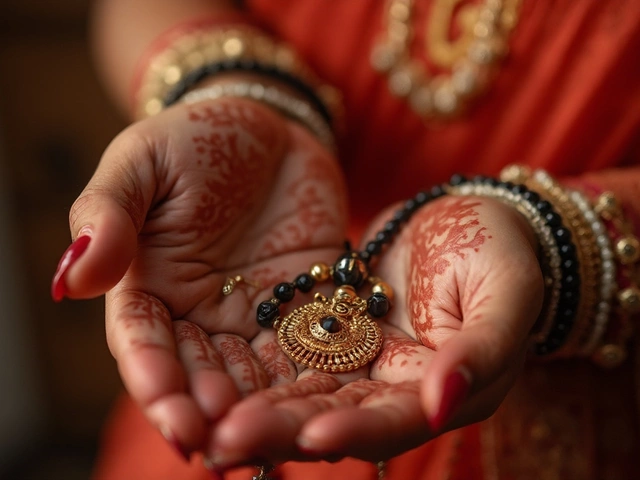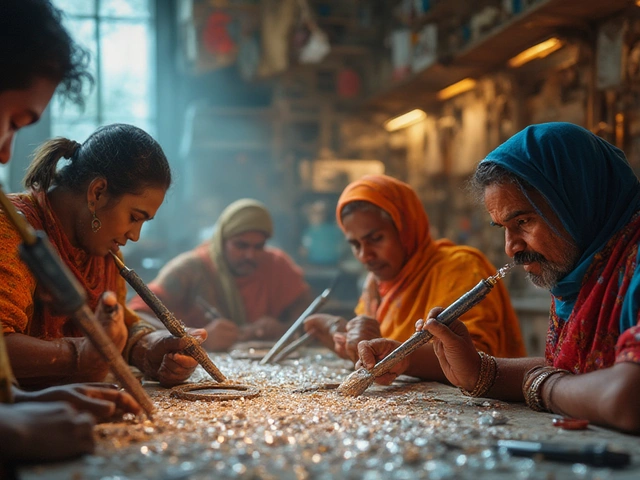
If you’ve ever admired that dramatic, gold-drenched jewellery every South Indian bride seems to wear, you’ve already noticed temple jewellery. But here’s something not everyone knows—temple jewellery also goes by another name: 'Devotional jewellery.' Originally made to decorate idols and temple dancers hundreds of years ago, this style has become a symbol of culture, heritage, and family pride.
People often ask what's different about it. Unlike your typical gold chains or bangles, temple jewellery features designs of gods, goddesses, peacocks, and floral patterns—all with a rich backstory. Some families even pass these pieces down for generations, treating them almost like family heirlooms.
If you’re searching for temple jewellery in India but don’t see that label, look out for terms like 'devotional jewellery' or 'Bharatanatyam jewellery' (since dancers still wear these for performances). The names change depending on where you are—sometimes in Tamil Nadu, it’s simply called 'traditional jewellery.'
- The Origins and Meaning
- Alternate Names and Why They Exist
- How to Recognize Real Temple Jewellery
- Modern Appeal and Everyday Wear
The Origins and Meaning
Temple jewellery has its roots smack in the heart of South India. If you trace it back, this style popped up during the Chola and Pandya dynasties, which is well over a thousand years ago. Craftsmen back then designed these pieces to decorate Hindu temple deities. That’s why you’ll notice motifs like goddess Lakshmi, elephants, and even lotus flowers carved or stamped into every item.
For ages, temple jewellery was crafted only from pure gold and decorated with rubies, emeralds, and pearls. These weren’t thrown together at random—the patterns and stones had meaning. Gold symbolized wealth and purity, rubies represented passion or power, and pearls were seen as a sign of wisdom.
Priests and royals used to directly fund these creations for temples. Over time, dancers—especially those performing Bharatanatyam and Kuchipudi—started sporting temple jewellery during their routines. It wasn’t just for show; every piece was a mark of respect to the gods and a nod to tradition.
Only a handful of towns became known for making temple jewellery. The town of Nagercoil in Tamil Nadu, for example, still has families passing down these crafts. Today, the methods have barely changed: most artisans still handcraft every item using skills and secrets picked up from their own parents and grandparents.
If you’re curious where the other name—'devotional jewellery'—comes in, it’s about the purpose. Every necklace or earring set was designed to honour something sacred. That spiritual link is the reason this South Indian ornament stands out from other types of Indian jewellery.
| Dynasty | Jewellery Purpose | Key Motifs |
|---|---|---|
| Chola | Adorning temple idols | Gods, goddesses, lotus |
| Pandya | Used for royal and religious ceremonies | Peacocks, swans, elephants |
Alternate Names and Why They Exist
Even though most people call it temple jewellery, this style pops up under more than one label. In South India, especially around Tamil Nadu and Andhra Pradesh, you’ll often hear 'devotional jewellery.' That’s because these pieces originally had one major job—adorning temple deities and dancers, not your average person.
It gets more interesting when you realize how dancers and priests refer to it. During Bharatnatyam dance performances, it’s called Bharatanatyam jewellery. Some shops will even list it as 'classical jewellery' or 'dance jewellery' to tap into that performance connection. And if you’re browsing a jewellery store in Chennai or Hyderabad, you might spot the term 'traditional South Indian jewellery'—another way sellers help people find what they’re after.
As for why so many names exist, it mainly comes down to how these pieces have traveled. Different parts of India picked up the style and added their own cultural spin, so now you’ll see it as:
- 'Devotional jewellery' in temples and processions
- 'Bharatanatyam jewellery' with classical dance costumes
- 'Heritage jewellery' in family heirloom collections
- 'Dance jewellery' on e-commerce platforms selling performance gear
In an interview with The Hindu, heritage jewellery expert Shobhana Vasudevan explained,
"Temple jewellery is so entwined with South Indian rituals and dance that every community calls it something that fits their own tradition. That’s why you find so many names for the same pieces."
If you’re searching online or at markets, keep these terms handy. Sometimes one store uses 'temple jewellery' and the next calls the same thing 'classical Indian jewellery.' Same art, just a different name to suit who’s buying and why.
Here’s something cool: about 70% of South Indian ornaments sold at major gold stores in Chennai get tagged with at least two of these labels, according to a 2023 survey by Indian Jeweller Magazine. So if you’re confused, you’re definitely not alone!

How to Recognize Real Temple Jewellery
Spotting genuine temple jewellery isn’t rocket science, but you do need to know what details matter. True pieces are almost always made with pure gold or high-quality silver, sometimes set with rubies, emeralds, or uncut diamonds known as polki stones. No plastic, glass, or flashy crystals—if you see those, you’re probably looking at a knockoff.
Want to know what makes the originals stand out? Here’s what to check:
- Weight and Finish: Real Indian jewellery from temples feels solid and has a slightly heavy weight. The finish is always smooth, with the designs looking sharp and clear.
- Design Elements: Look for motifs like Lakshmi, peacocks, elephants, and lotus flowers. These are classics you’ll find only in authentic temple ornaments.
- Backwork (Nakshi): The work on the backside should be neat. Poor quality jewellery often skips the detailing on the reverse, which is a dead giveaway it’s not the real deal.
- Handcrafted Details: Traditional South Indian ornaments are handcrafted, so small imperfections are expected. Mass-produced, machine-made jewellery usually looks too perfect and lacks depth.
- Hallmarks: Especially for newer pieces, look for the BIS hallmark or purity marking. This backs up its gold or silver value.
In places like Chennai’s Mylapore or Hyderabad’s Old City, you’ll spot stores that specialize in heritage jewellery with a reputation built over decades. If you’re shopping online, stick to sellers with detailed product images and return options, just in case.
Here’s a quick look at materials found in true temple jewellery versus imitations:
| Material | Authentic Temple Jewellery | Imitation |
|---|---|---|
| Gold Content | 22K or higher | Gold plated or alloy metal |
| Stones | Natural rubies, emeralds, polki diamonds | Glass, plastic, artificial stones |
| Craftsmanship | Handcrafted, detailed | Machine-made, basic finishes |
If you want something that’ll hold value and turn heads forever, old-school handcrafted pieces are hard to beat. New designs might look flashy, but the real magic sits with the classics. Plus, you’ll rarely see two genuine pieces that look exactly alike—they’re that unique.
Modern Appeal and Everyday Wear
Temple jewellery isn’t just for dance shows, weddings, or religious occasions anymore. It’s finding a home in everyday style, especially with younger generations mixing it up with casual outfits. Even in Sydney, it's not unusual to see people matching a chunky temple pendant with jeans and a T-shirt—turns out, Indian jewellery fits into global street style better than you'd think.
Designers have realised there’s a new crowd for temple jewellery. Now, you can spot smaller, lighter versions in shops that are a far cry from the massive, traditional sets usually worn at South Indian weddings. Think simple temple jewellery earrings or a minimal goddess-motif ring perfect for daily wear. Most pieces use silver and gold plating, making them way more affordable and lightweight for work or uni.
- Pair a small Lakshmi pendant with a plain kurti or even a button-up shirt for a touch of tradition without going overboard.
- Try layering thin temple chains with western outfits to give your look some edge.
- Temple jewellery-style statement studs can level up any casual Friday look—no need to go matchy-matchy.
- Brides these days are even renting ornate South Indian ornaments to avoid the hefty price but still rock the cultural vibe.
Just to give some perspective, in 2024, gold-plated and silver temple jewellery sales went up by nearly 40% in Indian metro cities, while international demand from places like Australia, the UK, and the US doubled compared to 2022. Here’s a quick look:
| Year | India (Metro Cities) | International (AU/UK/US) |
|---|---|---|
| 2022 | 100,000 pieces | 35,000 pieces |
| 2024 | 140,000 pieces | 70,000 pieces |
If you’re eyeing some heritage jewellery for your collection, there’s zero need to save it just for festivals. The key is picking up smaller, lighter pieces and mixing them with modern clothes. It turns out, temple jewellery is all about showing your style and culture at the same time. Go ahead—make it yours, every day.


